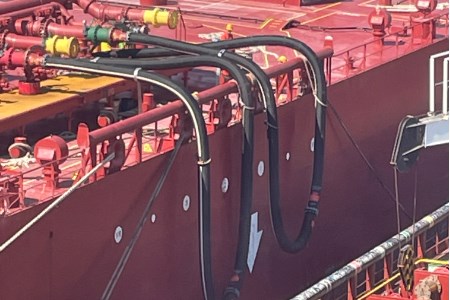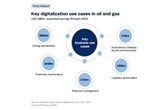Choosing the right hose
Published by Alfred Hamer,
Editorial Assistant
Oilfield Technology,
Jonathan Petit, Trelleborg Oil and Marine, argues that, amid the surge in global oil demand, with Ship-to-Ship (STS) operations growing in popularity, choosing the right marine hoses will play a key role in delivering the cost efficiencies required to take full advantage of this opportunity.

Against the backdrop of an increasingly dynamic global oil market, STS operation is a good example of how flexibility in logistics can increase supply capability. However, flexible logistical structures that are optimised for cost efficiencies must be reliable and therefore predictable.
STS operations allow vessels carrying liquid cargo to transfer offshore. For example, it enables port entry where draught restrictions would otherwise prevent vessel transfer, or it can support economically when a ship has multiple unloading points throughout its journey. As we know, STS transfer involves two tankers side-by-side. This requires operational precision and coordination – usually dictated within the expectations of commercial schedules and uncompromising weather and sea condition windows.
From the wider perspective of operational cost management, the complexity is especially apparent with the marine hose: a key element of STS operations that endures an extent of movement and handling unmatched by any other piece of transfer equipment.
Unlocking long-term OPEX savings
Meeting the needs of competing capital expenditure (CAPEX) and operating expenditure (OPEX) budgets is an ongoing challenge for energy projects. There can be a disconnect between procurement teams who are under pressure to limit front-end capital expenditure and the requirements of engineers and operators who must use and manage the equipment within the context of OPEX. This is common with hose selection, particularly when used in demanding STS operational environments.
By not systematically investing in solutions that deliver the best commercial performance over their total lifespan, operators are creating a false economy and potentially risk facing increasing and less predictable OPEX costs in the future. To put it into context, maintenance costs alone account for 20 - 60% of overall OPEX spending. This highlights the importance of both product quality and the value of preventative maintenance programs to offset unexpected costs of corrective maintenance (repair) or increasing curative maintenance (replacement).1 Taking a holistic approach to potential cost efficiencies, with more emphasis on expected product performance and lifecycle analysis rather than on upfront expense alone can be the better investment even though this can contradict some CAPEX approaches.
Efficiencies translate into a range of factors: from the extent of reliability and repair to reducing unforeseen operation interruptions, additional service costs and disrupted procedures. Owners and operators, therefore, benefit from a reliable hose type with proven and predictable performance within the context of their operation. Accepting hoses as being shorter-term consumables is unnecessary and compromises the objective of achieving an optimum cost structure.
Not all hoses are equal
The STS oil transfer hose operation is therefore a particularly fruitful area where optimum performance can reduce project lifecycle costs. Selecting hoses with proven performance can reduce operating expenditure and enhance the ongoing feasibility of the operation. As with most aspects of operational cost assessments, its value is in both the detail and the impact. The shorter distance between manifolds requires specific hose solutions. In addition, frequent and variable handling including derrick and deck storage between transfers means STS hoses endure wear beyond that of the obvious purpose of containing product flow.
A loaded hose on a vessel rail will require robust external construction because of the weight it carries, while the hose with no flow or vacuum when on the rail faces different stresses due to the absence of any internal counter pressure.
Meeting Standards and guidelines such as GMPHOM 2009, EN 1765:2016 / L15, and OCIMF is an important part of determining hose suitability, but seeking advantages beyond these requirements could provide distinct commercial advantages for the operator. The Trelleborg KLELINE STS offers improved performance than required by EN1765 with a +25% higher safety factor on burst pressure and +60% higher adhesion between layers compared to some alternative hoses. This delivers increased resistance to the demanding activities of the typical STS operation. The distinctive short-distance endpoints of STS operations mean that flange performance is a specifically important part of the STS marine hose. Frequent handling and stress concentration can leave flanges vulnerable to excessive corrosion and deformation. To avoid fatigue and premature ageing, it is vital that STS hoses are equipped with optimal flange design while a spool piece can be added to provide proper lifting lugs or lapped flange. KLELINE STS also benefits from a compact flange with the bumper on the top, thanks to the oil-resistant continuous inner liner and built-in gasket. This provides an effective and dependable sealing solution with no contact between media and the hose flange and structure.
The dual carcass technology that defines the KLELINE STS provides a body structure embedded in the compact flange and is reinforced with two independent carcasses of steel cable layers. This allows a continuous and homogeneous curvature in the sag of the U shape catenary despite the short distance between the two vessels. Each carcass fulfills an important function: resistance to internal pressure and strength to manage the loads and stresses of the external environment. This construction is also the ideal solution to accidental kink or crushing, which is more likely to occur in STS operations.
Such characteristics have positioned KLELINE STS as the workhorse of STS operations, particularly due to its ability to deliver predictable maintenance costs for the life cycle of the hose. But this is only part of the solution. Well-designed preventative maintenance schedules depend on accurate and worthwhile information, including hose history and performance. This is, after all, about achieving the longest and most dependable life from this employed capital asset.
A valuable tool in achieving intelligent hose management is the recent introduction of the KLELINE STS app by Trelleborg. This provides detailed management data on each KLELINE STS hose within the operator’s inventory, enabling a new level of hose management and performance monitoring. The app allows customers to access data related to their specific hoses wherever they are. This integrated offering of the KLELINE STS hose and app is a practical demonstration of how to sustain an optimised cost strategy within the context of a flexible logistical environment that is typical of STS operations.
The role of the hose supplier
Suppliers must never stop reviewing and evolving solutions to enable increased, reliable hose life and the operational and cost efficiencies that these can deliver. As part of this commitment, suppliers should recognise the value of working collaboratively with customers to share maintenance schedules that are supported by performance insights. Sharing such information and advice openly can help support customers to achieve ever improving cost efficiencies.
To conclude, informed selection and hose management can help improve the overall performance of STS operations and the growing opportunities that this sector presents.
References
- https://www.mckinsey.com/capabilities/operations/our-insights/the-future-of-maintenance-for-distributed-fixed-assets
Read the article online at: https://www.oilfieldtechnology.com/special-reports/30062025/choosing-the-right-hose/
You might also like
Rystad Energy: Key digital initiatives could save oil and gas industry over US$320 billion
Rystad reports on how digital innovation is changing the oilfield services sector.

